Haitian vs Inupiat Community Comparison
COMPARE
Haitian
Inupiat
Social Comparison
Social Comparison
Haitians
Inupiat
1,345
SOCIAL INDEX
11.0/ 100
SOCIAL RATING
314th/ 347
SOCIAL RANK
2,695
SOCIAL INDEX
24.5/ 100
SOCIAL RATING
244th/ 347
SOCIAL RANK
Inupiat Integration in Haitian Communities
The statistical analysis conducted on geographies consisting of 76,509,346 people shows a poor negative correlation between the proportion of Inupiat within Haitian communities in the United States with a correlation coefficient (R) of -0.156. On average, for every 1% (one percent) increase in Haitians within a typical geography, there is a decrease of 0.003% in Inupiat. To illustrate, in a geography comprising of 100,000 individuals, a rise of 1,000 Haitians corresponds to a decrease of 2.9 Inupiat.
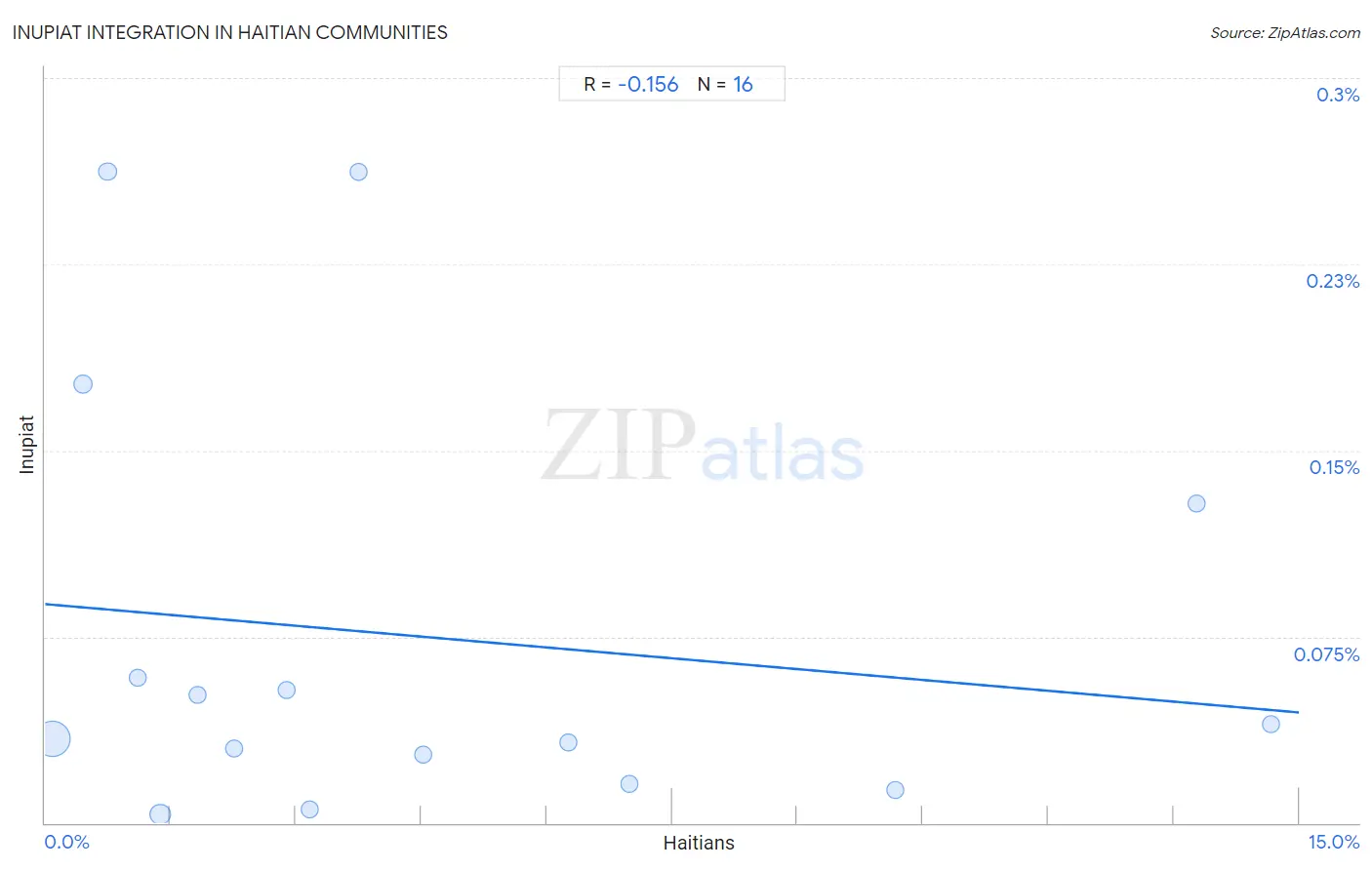
Haitian vs Inupiat Income
When considering income, the most significant differences between Haitian and Inupiat communities in the United States are seen in householder income over 65 years ($51,912 compared to $61,061, a difference of 17.6%), householder income under 25 years ($50,231 compared to $55,935, a difference of 11.4%), and median female earnings ($36,374 compared to $40,080, a difference of 10.2%). Conversely, both communities are more comparable in terms of per capita income ($37,289 compared to $36,999, a difference of 0.78%), median male earnings ($45,903 compared to $47,281, a difference of 3.0%), and median earnings ($40,918 compared to $43,000, a difference of 5.1%).

| Income Metric | Haitian | Inupiat |
| Per Capita Income | Tragic $37,289 | Tragic $36,999 |
| Median Family Income | Tragic $85,218 | Tragic $91,730 |
| Median Household Income | Tragic $73,306 | Tragic $78,841 |
| Median Earnings | Tragic $40,918 | Tragic $43,000 |
| Median Male Earnings | Tragic $45,903 | Tragic $47,281 |
| Median Female Earnings | Tragic $36,374 | Good $40,080 |
| Householder Age | Under 25 years | Tragic $50,231 | Exceptional $55,935 |
| Householder Age | 25 - 44 years | Tragic $80,055 | Tragic $84,619 |
| Householder Age | 45 - 64 years | Tragic $84,384 | Tragic $91,355 |
| Householder Age | Over 65 years | Tragic $51,912 | Average $61,061 |
| Wage/Income Gap | Exceptional 19.7% | Exceptional 20.8% |
Haitian vs Inupiat Poverty
When considering poverty, the most significant differences between Haitian and Inupiat communities in the United States are seen in single male poverty (13.2% compared to 20.0%, a difference of 51.1%), female poverty among 25-34 year olds (15.0% compared to 18.5%, a difference of 23.3%), and female poverty among 18-24 year olds (19.0% compared to 22.6%, a difference of 18.8%). Conversely, both communities are more comparable in terms of poverty (14.9% compared to 15.1%, a difference of 1.2%), child poverty among girls under 16 (20.5% compared to 20.8%, a difference of 1.3%), and female poverty (15.9% compared to 16.2%, a difference of 1.9%).
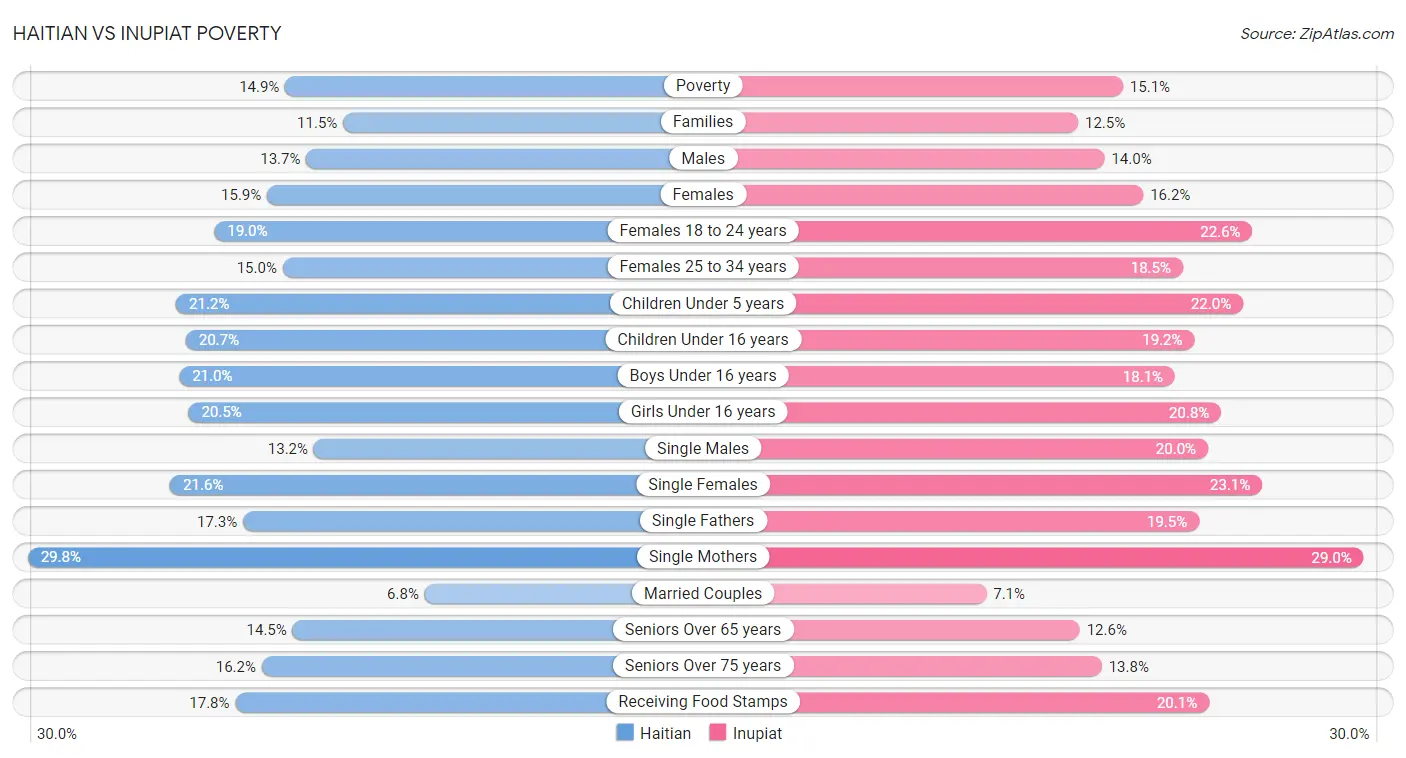
| Poverty Metric | Haitian | Inupiat |
| Poverty | Tragic 14.9% | Tragic 15.1% |
| Families | Tragic 11.5% | Tragic 12.5% |
| Males | Tragic 13.7% | Tragic 14.0% |
| Females | Tragic 15.9% | Tragic 16.2% |
| Females 18 to 24 years | Exceptional 19.0% | Tragic 22.6% |
| Females 25 to 34 years | Tragic 15.0% | Tragic 18.5% |
| Children Under 5 years | Tragic 21.2% | Tragic 22.0% |
| Children Under 16 years | Tragic 20.7% | Tragic 19.2% |
| Boys Under 16 years | Tragic 21.0% | Tragic 18.1% |
| Girls Under 16 years | Tragic 20.5% | Tragic 20.8% |
| Single Males | Tragic 13.2% | Tragic 20.0% |
| Single Females | Poor 21.6% | Tragic 23.1% |
| Single Fathers | Tragic 17.3% | Tragic 19.5% |
| Single Mothers | Poor 29.8% | Good 29.0% |
| Married Couples | Tragic 6.8% | Tragic 7.1% |
| Seniors Over 65 years | Tragic 14.5% | Tragic 12.6% |
| Seniors Over 75 years | Tragic 16.2% | Tragic 13.8% |
| Receiving Food Stamps | Tragic 17.8% | Tragic 20.1% |
Haitian vs Inupiat Unemployment
When considering unemployment, the most significant differences between Haitian and Inupiat communities in the United States are seen in unemployment among women with children under 6 years (8.6% compared to 17.7%, a difference of 105.4%), male unemployment (6.4% compared to 12.1%, a difference of 87.5%), and unemployment among ages 60 to 64 years (5.2% compared to 9.6%, a difference of 85.4%). Conversely, both communities are more comparable in terms of unemployment among seniors over 75 years (8.5% compared to 9.1%, a difference of 7.8%), unemployment among seniors over 65 years (5.3% compared to 5.8%, a difference of 10.6%), and female unemployment (6.1% compared to 8.2%, a difference of 34.0%).
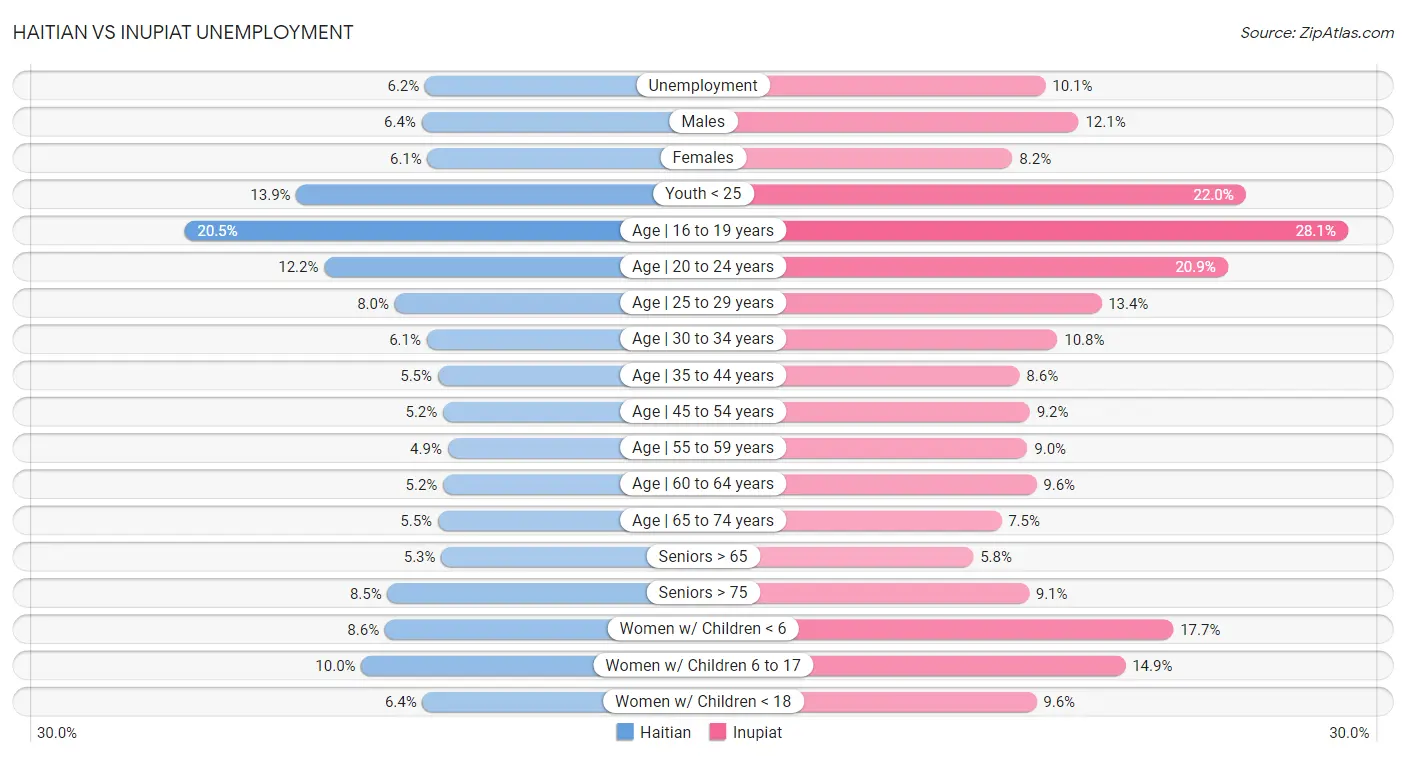
| Unemployment Metric | Haitian | Inupiat |
| Unemployment | Tragic 6.2% | Tragic 10.1% |
| Males | Tragic 6.4% | Tragic 12.1% |
| Females | Tragic 6.1% | Tragic 8.2% |
| Youth < 25 | Tragic 13.9% | Tragic 22.0% |
| Age | 16 to 19 years | Tragic 20.5% | Tragic 28.1% |
| Age | 20 to 24 years | Tragic 12.2% | Tragic 20.9% |
| Age | 25 to 29 years | Tragic 8.0% | Tragic 13.4% |
| Age | 30 to 34 years | Tragic 6.1% | Tragic 10.8% |
| Age | 35 to 44 years | Tragic 5.5% | Tragic 8.6% |
| Age | 45 to 54 years | Tragic 5.2% | Tragic 9.2% |
| Age | 55 to 59 years | Poor 4.9% | Tragic 9.0% |
| Age | 60 to 64 years | Tragic 5.2% | Tragic 9.6% |
| Age | 65 to 74 years | Tragic 5.5% | Tragic 7.5% |
| Seniors > 65 | Tragic 5.3% | Tragic 5.8% |
| Seniors > 75 | Exceptional 8.5% | Tragic 9.1% |
| Women w/ Children < 6 | Tragic 8.6% | Tragic 17.7% |
| Women w/ Children 6 to 17 | Tragic 10.0% | Tragic 14.9% |
| Women w/ Children < 18 | Tragic 6.4% | Tragic 9.6% |
Haitian vs Inupiat Labor Participation
When considering labor participation, the most significant differences between Haitian and Inupiat communities in the United States are seen in in labor force | age 30-34 (84.1% compared to 79.7%, a difference of 5.5%), in labor force | age 25-29 (83.7% compared to 79.8%, a difference of 4.9%), and in labor force | age 16-19 (33.4% compared to 35.0%, a difference of 4.8%). Conversely, both communities are more comparable in terms of in labor force | age > 16 (65.0% compared to 64.3%, a difference of 1.1%), in labor force | age 20-24 (73.6% compared to 74.6%, a difference of 1.4%), and in labor force | age 45-54 (82.8% compared to 79.9%, a difference of 3.7%).

| Labor Participation Metric | Haitian | Inupiat |
| In Labor Force | Age > 16 | Fair 65.0% | Tragic 64.3% |
| In Labor Force | Age 20-64 | Poor 79.3% | Tragic 76.1% |
| In Labor Force | Age 16-19 | Tragic 33.4% | Tragic 35.0% |
| In Labor Force | Age 20-24 | Tragic 73.6% | Poor 74.6% |
| In Labor Force | Age 25-29 | Tragic 83.7% | Tragic 79.8% |
| In Labor Force | Age 30-34 | Tragic 84.1% | Tragic 79.7% |
| In Labor Force | Age 35-44 | Exceptional 84.8% | Tragic 80.9% |
| In Labor Force | Age 45-54 | Good 82.8% | Tragic 79.9% |
Haitian vs Inupiat Family Structure
When considering family structure, the most significant differences between Haitian and Inupiat communities in the United States are seen in single father households (2.6% compared to 4.9%, a difference of 88.4%), births to unmarried women (38.6% compared to 52.1%, a difference of 35.0%), and family households with children (27.2% compared to 32.8%, a difference of 20.6%). Conversely, both communities are more comparable in terms of currently married (41.3% compared to 41.3%, a difference of 0.080%), single mother households (8.3% compared to 8.5%, a difference of 1.9%), and married-couple households (41.2% compared to 42.4%, a difference of 3.0%).

| Family Structure Metric | Haitian | Inupiat |
| Family Households | Exceptional 65.2% | Exceptional 67.8% |
| Family Households with Children | Poor 27.2% | Exceptional 32.8% |
| Married-couple Households | Tragic 41.2% | Tragic 42.4% |
| Average Family Size | Exceptional 3.37 | Exceptional 3.63 |
| Single Father Households | Tragic 2.6% | Tragic 4.9% |
| Single Mother Households | Tragic 8.3% | Tragic 8.5% |
| Currently Married | Tragic 41.3% | Tragic 41.3% |
| Divorced or Separated | Tragic 13.3% | Exceptional 11.4% |
| Births to Unmarried Women | Tragic 38.6% | Tragic 52.1% |
Haitian vs Inupiat Vehicle Availability
When considering vehicle availability, the most significant differences between Haitian and Inupiat communities in the United States are seen in no vehicles in household (14.9% compared to 29.9%, a difference of 100.2%), 4 or more vehicles in household (4.6% compared to 6.2%, a difference of 34.6%), and 1 or more vehicles in household (88.1% compared to 71.5%, a difference of 23.1%). Conversely, both communities are more comparable in terms of 3 or more vehicles in household (15.5% compared to 16.9%, a difference of 8.9%), 2 or more vehicles in household (47.6% compared to 42.6%, a difference of 11.6%), and 1 or more vehicles in household (88.1% compared to 71.5%, a difference of 23.1%).

| Vehicle Availability Metric | Haitian | Inupiat |
| No Vehicles Available | Tragic 14.9% | Tragic 29.9% |
| 1+ Vehicles Available | Tragic 88.1% | Tragic 71.5% |
| 2+ Vehicles Available | Tragic 47.6% | Tragic 42.6% |
| 3+ Vehicles Available | Tragic 15.5% | Tragic 16.9% |
| 4+ Vehicles Available | Tragic 4.6% | Fair 6.2% |
Haitian vs Inupiat Education Level
When considering education level, the most significant differences between Haitian and Inupiat communities in the United States are seen in no schooling completed (2.9% compared to 1.5%, a difference of 87.5%), associate's degree (40.0% compared to 32.6%, a difference of 22.7%), and bachelor's degree (31.3% compared to 25.8%, a difference of 21.4%). Conversely, both communities are more comparable in terms of doctorate degree (1.3% compared to 1.3%, a difference of 0.050%), ged/equivalency (82.1% compared to 83.1%, a difference of 1.2%), and 12th grade, no diploma (88.5% compared to 90.1%, a difference of 1.7%).
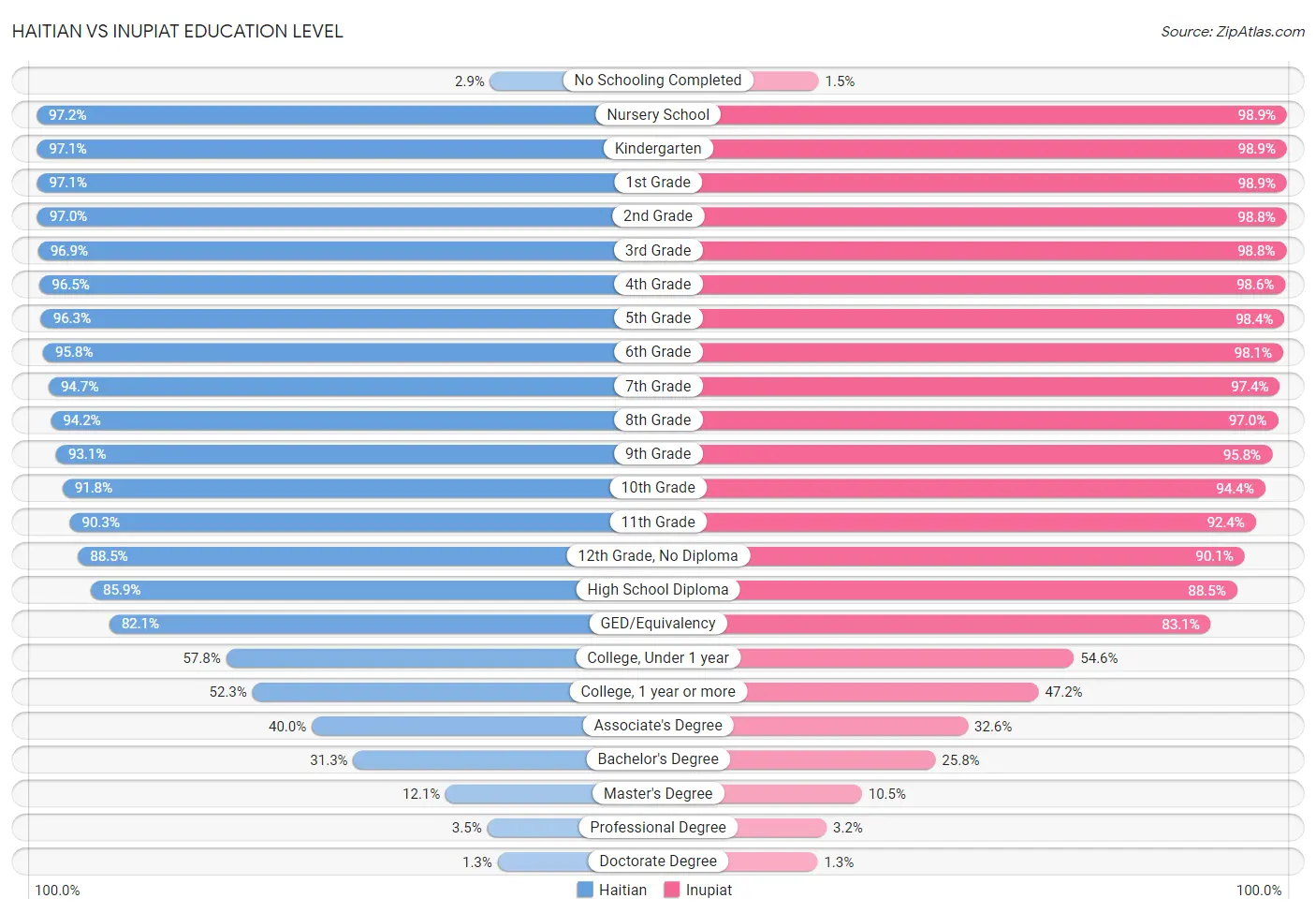
| Education Level Metric | Haitian | Inupiat |
| No Schooling Completed | Tragic 2.9% | Exceptional 1.5% |
| Nursery School | Tragic 97.2% | Exceptional 98.9% |
| Kindergarten | Tragic 97.1% | Exceptional 98.9% |
| 1st Grade | Tragic 97.1% | Exceptional 98.9% |
| 2nd Grade | Tragic 97.0% | Exceptional 98.8% |
| 3rd Grade | Tragic 96.9% | Exceptional 98.8% |
| 4th Grade | Tragic 96.5% | Exceptional 98.6% |
| 5th Grade | Tragic 96.3% | Exceptional 98.4% |
| 6th Grade | Tragic 95.8% | Exceptional 98.1% |
| 7th Grade | Tragic 94.7% | Exceptional 97.4% |
| 8th Grade | Tragic 94.2% | Exceptional 97.0% |
| 9th Grade | Tragic 93.1% | Exceptional 95.8% |
| 10th Grade | Tragic 91.8% | Exceptional 94.4% |
| 11th Grade | Tragic 90.3% | Average 92.4% |
| 12th Grade, No Diploma | Tragic 88.5% | Tragic 90.1% |
| High School Diploma | Tragic 85.9% | Poor 88.5% |
| GED/Equivalency | Tragic 82.1% | Tragic 83.1% |
| College, Under 1 year | Tragic 57.8% | Tragic 54.6% |
| College, 1 year or more | Tragic 52.3% | Tragic 47.2% |
| Associate's Degree | Tragic 40.0% | Tragic 32.6% |
| Bachelor's Degree | Tragic 31.3% | Tragic 25.8% |
| Master's Degree | Tragic 12.1% | Tragic 10.5% |
| Professional Degree | Tragic 3.5% | Tragic 3.2% |
| Doctorate Degree | Tragic 1.3% | Tragic 1.3% |
Haitian vs Inupiat Disability
When considering disability, the most significant differences between Haitian and Inupiat communities in the United States are seen in disability age under 5 (1.3% compared to 3.7%, a difference of 196.5%), hearing disability (2.6% compared to 4.7%, a difference of 79.5%), and disability age 65 to 74 (23.4% compared to 34.5%, a difference of 47.3%). Conversely, both communities are more comparable in terms of disability age 5 to 17 (5.8% compared to 5.7%, a difference of 2.2%), cognitive disability (17.5% compared to 16.9%, a difference of 3.7%), and disability (11.7% compared to 12.2%, a difference of 3.8%).
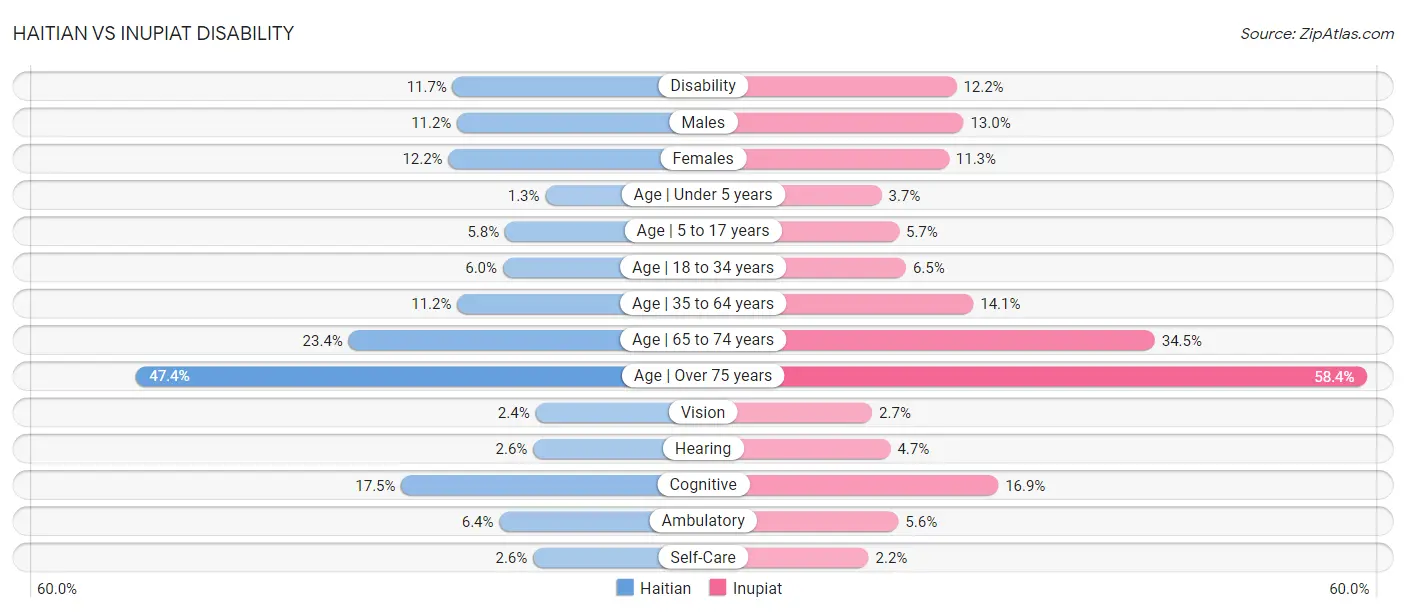
| Disability Metric | Haitian | Inupiat |
| Disability | Average 11.7% | Tragic 12.2% |
| Males | Average 11.2% | Tragic 13.0% |
| Females | Average 12.2% | Exceptional 11.3% |
| Age | Under 5 years | Fair 1.3% | Tragic 3.7% |
| Age | 5 to 17 years | Tragic 5.8% | Fair 5.7% |
| Age | 18 to 34 years | Exceptional 6.0% | Good 6.5% |
| Age | 35 to 64 years | Average 11.2% | Tragic 14.1% |
| Age | 65 to 74 years | Average 23.4% | Tragic 34.5% |
| Age | Over 75 years | Average 47.4% | Tragic 58.4% |
| Vision | Tragic 2.4% | Tragic 2.7% |
| Hearing | Exceptional 2.6% | Tragic 4.7% |
| Cognitive | Poor 17.5% | Exceptional 16.9% |
| Ambulatory | Tragic 6.4% | Exceptional 5.6% |
| Self-Care | Tragic 2.6% | Exceptional 2.2% |